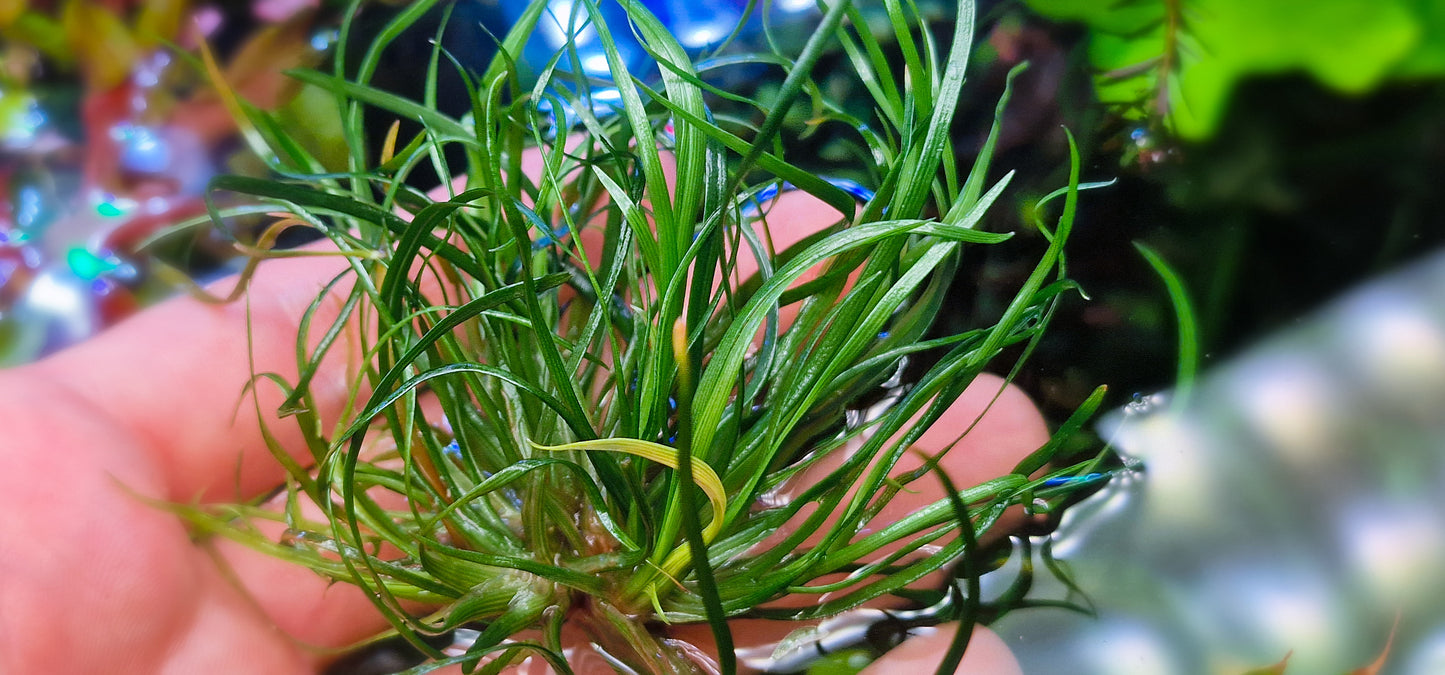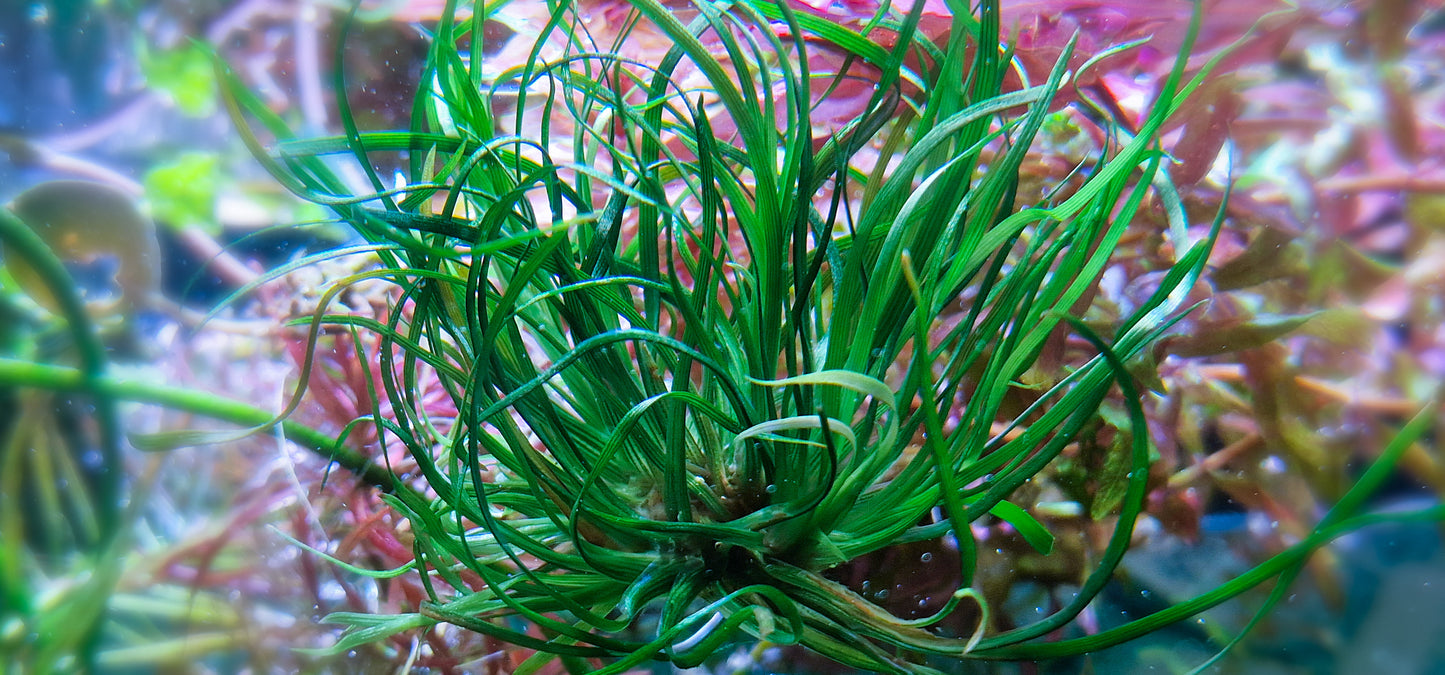Eriocaulon sp. "Japan Needle Leaf" rare plants aquarium 1plant
Eriocaulon sp. "Japan Needle Leaf" rare plants aquarium 1plant
Couldn't load pickup availability
English:
Eriocaulon sp. “Japan Needle Leaf” – Rare Aquarium Plant.
This rare Eriocaulon is often sold under the name “Japan Needle Leaf”, although it is not actually native to Japan. The name likely originated from early imports into the Japanese aquarium trade, where it first gained popularity before spreading internationally. In reality, this plant is believed to come from rocky, fast-flowing rivers in South Asia, particularly India, where it grows anchored to gravel or stone in clear, oxygen-rich waters.
It forms a dense rosette with extremely fine, flexible leaves, deep green and smooth, measuring around 30–40 cm in length and only 1.5 mm in width. The leaves are arranged in a rare distichous pattern along a short, firm rhizome that branches over time into a compact clump. Occasionally, young leaves may appear curled but quickly straighten. It can attach naturally to hardscape materials such as rocks or driftwood, making it versatile in aquascaping. Flower stalks are shorter than the leaves; when emergent, they produce spherical flower heads, and when submerged, they form adventitious plantlets for easy propagation.
Cultivation: strong light (40–60 PAR at substrate or 2000–3500 lumens over 60 L), CO₂ injection (20–30 ppm), nutrient-rich substrate or regular water column fertilisation. Tolerates medium-hard water if CO₂ is stable. Ideal parameters: pH 5.5–6.5, GH 3–6 (adaptable to GH 8), KH 0–2, conductivity 120–180 µS. Growth is slow to moderate. Iron or micronutrient deficiency can cause pale tips.
Adaptation: grown submerged, it continues without melt, producing denser foliage under optimal conditions.
Its rarity, unique leaf form, and intriguing trade history make it a collector’s plant – sought after by aquascapers seeking fine texture without invasive runners.
Italiano:
Eriocaulon sp. “Japan Needle Leaf” – Pianta d’Acquario Rara.
Questa rara varietà di Eriocaulon è comunemente venduta come “Japan Needle Leaf”, ma non è in realtà originaria del Giappone. Il nome deriva probabilmente dai primi esemplari importati nel commercio acquariofilo giapponese, dove divenne popolare prima di diffondersi a livello internazionale. In natura, sembra provenire da fiumi rapidi e rocciosi del Sud Asia, in particolare dell’India, dove cresce ancorata a ghiaia o pietre in acque limpide e ricche di ossigeno.
Forma una rosetta densa con foglie sottilissime, flessibili, verde scuro e lisce, lunghe circa 30–40 cm e larghe solo 1,5 mm. Le foglie sono disposte in modo distico, caratteristica rara per un Eriocaulon, lungo un rizoma corto e robusto che col tempo si ramifica formando un cespo compatto. Talvolta le foglie giovani nascono leggermente arricciate ma si raddrizzano rapidamente. Può ancorarsi naturalmente a rocce o legni, rendendola molto versatile nel layout. Gli steli fiorali sono più corti delle foglie; se emergono, producono capolini sferici, mentre sommersi generano piantine avventizie per una propagazione semplice.
Coltivazione: luce intensa (40–60 PAR sul fondo o 2000–3500 lumen su 60 L), CO₂ (20–30 ppm), substrato ricco o fertilizzazione regolare in colonna. Tollera acqua medio-dura se il CO₂ è stabile. Parametri ideali: pH 5.5–6.5, GH 3–6 (adattabile fino a GH 8), KH 0–2, conducibilità 120–180 µS. Crescita lenta-moderata. Carenze di ferro o microelementi possono causare punte pallide.
Adattamento: coltivata sommersa, cresce senza sciogliersi, aumentando la densità fogliare in condizioni ottimali.
La sua rarità, la forma particolare delle foglie e la storia del nome la rendono una pianta da collezione molto apprezzata.
Français :
Eriocaulon sp. “Japan Needle Leaf” – Plante d’Aquarium Rare.
Cette variété rare d’Eriocaulon est souvent vendue sous le nom “Japan Needle Leaf”, bien qu’elle ne soit pas originaire du Japon. Ce nom vient probablement des premières importations dans le commerce aquariophile japonais, où elle a gagné en popularité avant de se diffuser à l’international. En réalité, elle proviendrait de rivières rapides et rocheuses d’Asie du Sud, notamment d’Inde, où elle pousse fixée à des graviers ou rochers dans des eaux claires et riches en oxygène.
Elle forme une rosette dense aux feuilles très fines et souples, vert foncé et lisses, mesurant environ 30–40 cm de long pour seulement 1,5 mm de large. Les feuilles sont disposées de manière distique, particularité rare chez un Eriocaulon, le long d’un court rhizome ferme qui se ramifie avec le temps en une touffe compacte. Les jeunes feuilles peuvent apparaître légèrement recourbées mais se redressent rapidement. Elle s’ancre facilement aux pierres ou au bois, ce qui la rend très polyvalente en aquascaping. Les hampes florales sont plus courtes que les feuilles : émergées, elles portent des inflorescences sphériques ; immergées, elles produisent des plantules adventives pour une multiplication facile.
Culture : lumière forte (40–60 PAR au substrat ou 2000–3500 lumens pour 60 L), injection de CO₂ (20–30 ppm), substrat nutritif ou fertilisation régulière dans la colonne d’eau. Tolère une eau moyennement dure si le CO₂ est stable. Paramètres idéaux : pH 5,5–6,5, GH 3–6 (adaptable jusqu’à GH 8), KH 0–2, conductivité 120–180 µS. Croissance lente à modérée. Une carence en fer ou oligo-éléments peut entraîner un éclaircissement des pointes.
Adaptation : cultivée en immergé, elle poursuit sa croissance sans fonte, avec un feuillage plus dense en conditions optimales.
Sa rareté, sa forme unique et l’histoire de son nom en font une plante de collection recherchée.
Deutsch:
Eriocaulon sp. “Japan Needle Leaf” – Seltene Aquariumpflanze.
Diese seltene Eriocaulon-Form wird häufig unter dem Namen “Japan Needle Leaf” verkauft, stammt jedoch nicht aus Japan. Der Name geht vermutlich auf die ersten Importe in den japanischen Aquarienhandel zurück, wo sie populär wurde, bevor sie international bekannt wurde. Tatsächlich soll sie aus schnell fließenden, felsigen Flüssen in Südasien stammen, insbesondere aus Indien, wo sie an Kies oder Steinen in klarem, sauerstoffreichem Wasser wächst.
Sie bildet eine dichte Rosette mit extrem feinen, biegsamen, tiefgrünen und glatten Blättern, etwa 30–40 cm lang und nur 1,5 mm breit. Die Blätter sind in einer distichen Anordnung entlang eines kurzen, festen Rhizoms angeordnet, das sich mit der Zeit verzweigt und einen kompakten Horst bildet. Junge Blätter erscheinen manchmal leicht eingerollt, richten sich jedoch schnell auf. Sie verankert sich leicht an Steinen oder Wurzeln, was sie in der Gestaltung sehr vielseitig macht. Blütenstiele sind kürzer als die Blätter; ragen sie aus dem Wasser, bilden sich kugelförmige Blütenköpfe, bleiben sie untergetaucht, entstehen Adventivpflanzen zur einfachen Vermehrung.
Pflege: starke Beleuchtung (40–60 PAR auf Substrathöhe oder 2000–3500 Lumen für 60 L), CO₂-Zufuhr (20–30 ppm), nährstoffreicher Bodengrund oder regelmäßige Düngung über die Wassersäule. Verträgt mittelhartes Wasser bei stabiler CO₂-Zufuhr. Ideale Werte: pH 5,5–6,5, GH 3–6 (anpassbar bis GH 8), KH 0–2, Leitwert 120–180 µS. Langsames bis mäßiges Wachstum. Eisen- oder Spurenelementmangel kann zu blassen Spitzen führen.
Anpassung: bereits submers kultiviert, wächst sie ohne Schmelzen weiter und entwickelt unter optimalen Bedingungen dichteres Laub.
Ihre Seltenheit, die besondere Blattstruktur und die Geschichte ihres Namens machen sie zu einer begehrten Sammlerpflanze.




